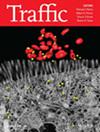CD14循环调节LPS诱导的小鼠巨噬细胞炎症反应
IF 2.5
3区 生物学
Q3 CELL BIOLOGY
引用次数: 2
摘要
TLR4被细菌内毒素脂多糖(LPS)激活,并触发两个促炎信号级联反应:一个是依赖于MyD88的质膜信号级联反应,另一个是依赖于TRIF的内体信号级联反应。不充分的炎症反应会导致败血症,对机体有害。因此,治疗性调节TLR4信号的新方法正在被寻求。TLR4活性与CD14的存在密切相关,CD14是一种GPI锚定蛋白,可将LPS单体转移到受体并控制其内吞作用。在这项研究中,我们关注的是CD14运输作为一个仍然知之甚少的影响TLR4活性的因素。两项独立的实验表明,在未受刺激和受刺激的细胞内吞后,CD14都可以循环回到质膜上。CD14的这一转运途径可以通过分类连接蛋白(SNX) 1、2和6来控制,对于维持CD14的表面水平和总水平很重要,但也会影响TLR4的数量。这些SNXs的沉默减弱了TLR4的CD14依赖性内体信号,使它们成为巨噬细胞对LPS炎症反应的治疗性调节的新靶点。本文章由计算机程序翻译,如有差异,请以英文原文为准。
CD14 recycling modulates LPS‐induced inflammatory responses of murine macrophages
TLR4 is activated by the bacterial endotoxin lipopolysaccharide (LPS) and triggers two proinflammatory signaling cascades: a MyD88‐dependent one in the plasma membrane, and the following TRIF‐dependent one in endosomes. An inadequate inflammatory reaction can be detrimental for the organism by leading to sepsis. Therefore, novel approaches to therapeutic modulation of TLR4 signaling are being sought after. The TLR4 activity is tightly connected with the presence of CD14, a GPI‐anchored protein that transfers LPS monomers to the receptor and controls its endocytosis. In this study we focused on CD14 trafficking as a still poorly understood factor affecting TLR4 activity. Two independent assays were used to show that after endocytosis CD14 can recycle back to the plasma membrane in both unstimulated and stimulated cells. This route of CD14 trafficking can be controlled by sorting nexins (SNX) 1, 2 and 6, and is important for maintaining the surface level and the total level of CD14, but can also affect the amount of TLR4. Silencing of these SNXs attenuated especially the CD14‐dependent endosomal signaling of TLR4, making them a new target for therapeutic regulation of the inflammatory response of macrophages to LPS.
求助全文
通过发布文献求助,成功后即可免费获取论文全文。
去求助
来源期刊

Traffic
生物-细胞生物学
CiteScore
8.10
自引率
2.20%
发文量
50
审稿时长
2 months
期刊介绍:
Traffic encourages and facilitates the publication of papers in any field relating to intracellular transport in health and disease. Traffic papers span disciplines such as developmental biology, neuroscience, innate and adaptive immunity, epithelial cell biology, intracellular pathogens and host-pathogen interactions, among others using any eukaryotic model system. Areas of particular interest include protein, nucleic acid and lipid traffic, molecular motors, intracellular pathogens, intracellular proteolysis, nuclear import and export, cytokinesis and the cell cycle, the interface between signaling and trafficking or localization, protein translocation, the cell biology of adaptive an innate immunity, organelle biogenesis, metabolism, cell polarity and organization, and organelle movement.
All aspects of the structural, molecular biology, biochemistry, genetics, morphology, intracellular signaling and relationship to hereditary or infectious diseases will be covered. Manuscripts must provide a clear conceptual or mechanistic advance. The editors will reject papers that require major changes, including addition of significant experimental data or other significant revision.
Traffic will consider manuscripts of any length, but encourages authors to limit their papers to 16 typeset pages or less.
 求助内容:
求助内容: 应助结果提醒方式:
应助结果提醒方式:


